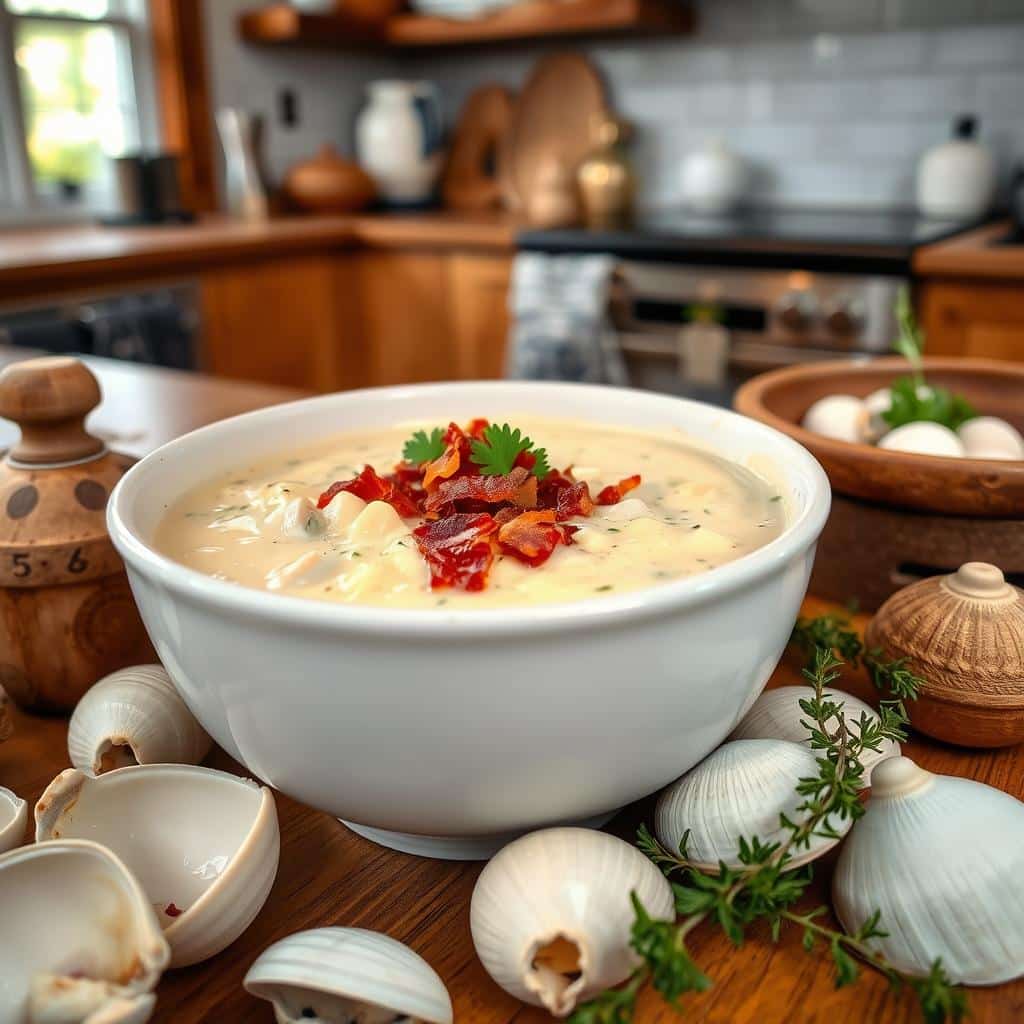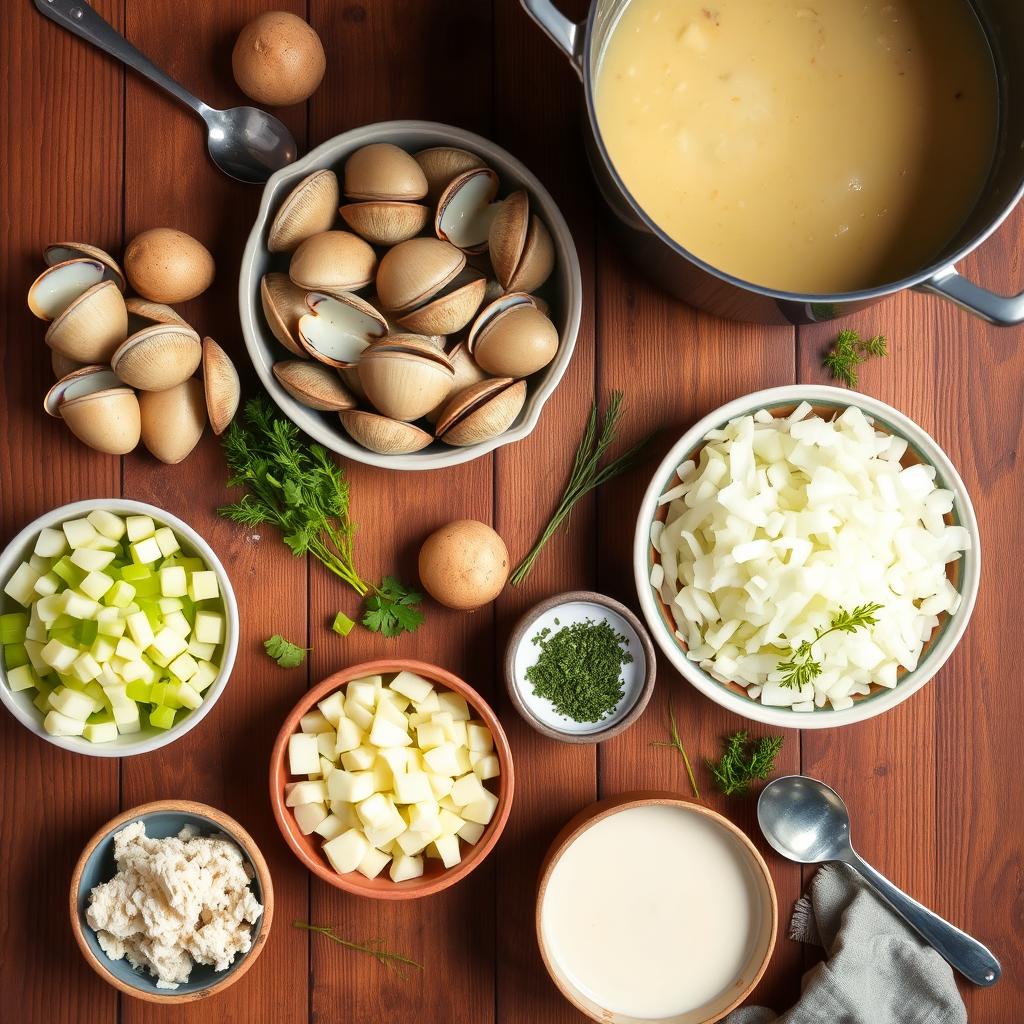When winter winds hit the Northeast, nothing beats a warm bowl of New England clam chowder. This beloved soup has been a favorite in America for centuries. It takes diners on a journey to the coastal towns of the region with every spoonful. Enjoyed by the fireplace or on a windy day, this clam chowder is true comfort food.
The New England clam chowder is more than a meal; it’s a tradition and a link to the sea. Its creamy broth, filled with tender seafood chowder, potatoes, and veggies, is a feast for the senses. It warms the heart and nourishes the soul.
Key Takeaways
- New England clam chowder is a beloved comfort food with a rich history in American cuisine.
- The creamy, decadent broth and tender clams create a symphony of flavors.
- This iconic dish transports diners to the quaint coastal towns of the Northeast.
- Mastering the perfect requires attention to detail and the right techniques.
- Enjoying a bowl of this comforting soup is a cherished tradition for many.
The Rich History of New England Clam Chowder
New England clam chowder has a long and fascinating history. It dates back to Colonial America’s early days. Over time, different areas along the Northeast coast have added their own twists, making it a beloved seafood dish.
Origins in Colonial America
The story of clam chowder starts in Colonial America’s coastal towns. Clamming was a key way for families to get food. Early recipes used simple things like potatoes, onions, and salt pork, showing the settlers’ limited resources.
Evolution Through Centuries
As time went on, clam chowder got more ingredients and cooking methods. It spread across the region, picking up different flavors. Now, you can find the creamy New England style, the tomato-based Manhattan chowder, and the clear Rhode Island chowder.
Regional Variations
- New England Clam Chowder: The classic, creamy version with potatoes, onions, and clams.
- Manhattan Clam Chowder: A tomato-based version with a thinner broth and more vegetables.
- Rhode Island Clam Chowder: A clear-broth chowder that showcases the fresh, briny flavor of the clams.
The history of clam chowder shows its lasting charm. From its simple start in Colonial America to its current fame, this stew still wins over many. It’s a creamy, comforting dish that’s loved by all.

Essential Ingredients for Authentic Clam Chowder
Making a delicious New England clam chowder needs the right mix of ingredients. This creamy soup is loved for its comfort. It combines the salty taste of fresh clams with the creaminess of cream and the earthiness of veggies.
At the core of a true clam chowder are the clams. They add a unique flavor and texture. Potatoes are also key, making the soup thick and creamy.
- Clams (such as littleneck or cherrystone)
- Potatoes (russet or Yukon Gold)
- Onions
- Celery
- Bacon (optional, for a smoky note)
- Heavy cream or half-and-half
- Butter
- Thyme, parsley, and other herbs (for seasoning)
The mix of these main ingredients makes clam chowder so comforting. Each part is important for the perfect taste and texture. This makes the dish a classic favorite.
| Ingredient | Purpose |
|---|---|
| Clams | Provide the briny, seafood flavor and tender texture |
| Potatoes | Contribute to the chowder’s creamy consistency and absorb the flavors |
| Onions and Celery | Add depth of flavor and aromatic notes |
| Bacon (optional) | Imparts a smoky, savory element |
| Cream or Half-and-Half | Enhances the rich, velvety texture of the chowder |
| Butter | Provides a luxurious mouthfeel and helps bind the ingredients |
| Herbs | Contribute fresh, herbaceous notes to balance the dish |
Choosing and mixing these key ingredients well lets you make a authentic New England clam chowder. It’s sure to please your taste buds and warm your heart.

Selecting and Preparing Fresh Clams for Your Chowder
Creating the perfect New England clam chowder starts with fresh shellfish. Choosing the right clams and cleaning them properly is crucial. Let’s look at how to pick and prepare your clams for a delicious seafood dish.
Types of Clams to Use
Quahogs, or hard-shell clams, are the traditional choice for New England chowder. They offer a briny flavor and chewy texture. Cherrystone and littleneck clams are also great options, though smaller and just as tasty.
Cleaning and Shucking Techniques
- Start by scrubbing the clams under cold water to remove dirt.
- Then, use a sharp knife to shuck them, keeping the juices inside.
- Rinse the clams again to get rid of any sand or impurities.
Fresh vs. Canned Options
Fresh, shucked clams make a chowder more authentic and flavorful. They offer a better texture and taste than canned clams. But, if fresh clams are hard to find, high-quality canned ones can be a good substitute.
| Fresh Clams | Canned Clams |
|---|---|
| Provide superior texture and flavor | More convenient but lack the depth of fresh clams |
| Require more preparation time | Ready-to-use, saving time in the kitchen |
| Offer a more authentic chowder experience | Can be a viable substitute when fresh clams are unavailable |
Choosing between fresh and canned clams depends on your preferences and what’s available. The most important thing is to use high-quality shellfish for the best flavor in your seafood dish.
Internal Linking Opportunities
Here are internal linking opportunities for your article “Creamy New England Clam Chowder Recipe | Classic Comfort” from Colors Recipes:
- Carvel Ice Cream Cake
Anchor Text: “Pair your clam chowder with indulgent desserts like Carvel Ice Cream Cake for a satisfying meal.” - Classic Chocolate Chip Cookies
Anchor Text: “End your comforting meal with these classic chocolate chip cookies for a sweet finish.” - Crispy Fried Chicken with Mashed Potatoes
Anchor Text: “For a hearty combination, serve clam chowder alongside crispy fried chicken and mashed potatoes.”
Kitchen Equipment and Tools You’ll Need
Creating the perfect chowder recipe requires the right tools. From a strong pot to a sharp knife, each tool is key. They help you get that rich, creamy soup texture.
You’ll need a big, heavy pot or Dutch oven to start. It ensures even heat and prevents burning. A sharp knife is vital for chopping veggies. A solid cutting board is needed for prep work.
- Large, heavy-bottomed pot or Dutch oven
- Sharp chef’s knife
- Cutting board
- Wooden spoon or ladle
- Strainer or colander
- Measuring cups and spoons
A sturdy wooden spoon or ladle is great for stirring and serving. A strainer or colander is useful for cleaning and draining clams. Measuring cups and spoons help you measure ingredients accurately, making your soup balanced.
| Equipment | Purpose |
|---|---|
| Large, heavy-bottomed pot or Dutch oven | Ensures even heat distribution and prevents burning or scorching |
| Sharp chef’s knife | Crucial for dicing vegetables |
| Cutting board | Provides a stable surface for prep work |
| Wooden spoon or ladle | Used for stirring and serving the chowder recipe |
| Strainer or colander | Helps clean and drain the clams |
| Measuring cups and spoons | Ensures accurate portioning of ingredients for a balanced creamy soup |
With these tools, you’re ready to make a delicious, authentic chowder. It will impress your guests and satisfy your taste buds.
Step-by-Step Cooking Instructions
Making the perfect clam chowder, especially the classic New England clam chowder, is a fun journey. Let’s go through the steps to make this loved seafood chowder in your kitchen.
Creating the Base
Begin by cooking thick-cut bacon in a big pot or Dutch oven over medium heat. When the bacon is crispy, take it out, leaving the fat behind. This fat will be the base of your chowder.
Adding Vegetables
Then, add diced onions, celery, and potatoes to the pot. Cook these veggies in the bacon fat until they’re soft and smell good, about 10 minutes. This mix of veggies will make your clam chowder richer and more complex.
Incorporating Clams and Cream
Now, it’s time for the main ingredient – the clams. You can use fresh, shucked clams or top-notch canned clams. Add the clams gently to the pot, then a bit of heavy cream or half-and-half. Let the chowder simmer until the clams are done and the flavors mix well, about 15-20 minutes.
Don’t forget to season your New England clam chowder with salt, pepper, and a bit of fresh thyme or parsley. Adjust the seasoning to your liking, and you’re all set to serve this cozy and tasty dish.
Tips for Achieving the Perfect Consistency
Making a creamy clam chowder is all about getting the right consistency. You might like it thick and hearty or light and brothy. Here are some tips to help you get your creamy soup just right.
Starch is key to thickening your clam chowder. You can use potatoes, flour, or even a bit of clam bisque. Try different starches and amounts to find what you like best.
Changing the liquid-to-solid ratio also affects the soup’s thickness. More broth or milk makes it thinner. More potatoes, onions, and clams make it thicker and more filling.
The simmering time is important too. Letting the chowder simmer slowly helps the flavors meld together. This makes it creamy and rich. Don’t rush it, or it might not turn out right.
With these tips, you’ll be making perfect clam chowder in no time. Enjoy the feeling of a job well done with a delicious, comforting bowl of why is clam chowder so good?.
Common Mistakes to Avoid When Making Clam Chowder
Making the perfect chowder recipe is a fun challenge. But, it’s easy to make mistakes. As you start your seafood dish journey, watch out for these common errors that can ruin your clam chowder.
Temperature Control
Keeping the right temperature is crucial for great clam chowder. Overcooking the clams makes them tough and rubbery. Undercooking leaves them raw and unpleasant. Finding the perfect balance is essential for that tender, juicy bite.
Seasoning Balance
Seasoning is the heart of any chowder recipe. But, it’s easy to add too much or too little. Too little seasoning makes the dish bland. Too much can overpower the clams’ delicate flavors. Be careful with salt, pepper, and spices.
Texture Problems
Getting the right creamy texture is tricky. Too much thickener makes it gloopy. Not enough makes it watery. Try different thickeners like roux, cornstarch, or potato starch to find the perfect smoothness.
Remember these common mistakes and adjust accordingly. You’ll soon make a chowder recipe that will wow your taste buds and guests. Enjoy the process, try new things, and aim for clam chowder perfection.
Serving Suggestions and Garnishing Ideas
Serving new england clam chowder right can make a big difference. Think about how you can make it look and taste even better. Here are some ideas to enhance your seafood chowder experience.
Serving it in a sourdough bread bowl is a classic choice. It’s not just pretty; it also soaks up the creamy soup flavors. Serve it with a fresh salad or some crusty bread for a full meal.
Oyster crackers are a must for new england clam chowder. They add a nice crunch to the smooth chowder. Try flavored crackers like garlic or herbs for more taste.
Top your seafood chowder with fresh herbs like parsley, chives, or thyme. They add color and a fresh aroma. For a crunchy touch, add crispy bacon bits or fried onions.
Pair your new england clam chowder with warm bread or a green salad. A crisp white wine or a cold beer goes well with it too.
By presenting and garnishing your new england clam chowder well, you can make it unforgettable. It’s a great way to impress your guests.
Storage and Reheating Guidelines
Enjoying homemade clam chowder is a treat. But what about leftovers? It’s important to store and reheat them right to keep the flavors and textures great.
Storing Leftover Clam Chowder
To keep your clam chowder fresh, follow these steps:
- Put leftovers in an airtight container within 2 hours of cooking.
- It will stay good in the fridge for 3-4 days.
- Freeze it in portions for up to 3 months. This keeps it fresh longer.
Reheating Clam Chowder
Here’s how to reheat your clam chowder perfectly:
- Thaw frozen chowder in the fridge overnight before reheating.
- Heat it on the stovetop over medium, stirring often, until warm.
- Don’t let it boil, as it can curdle or get grainy.
- If it’s too thick, add a bit of milk or cream.
By storing and reheating your clam chowder right, you can enjoy it for days.
| Storage Method | Shelf Life |
|---|---|
| Refrigerator | 3-4 days |
| Freezer | Up to 3 months |
Conclusion
New England clam chowder is a classic loved by many for generations. It’s creamy and comforting, showing the rich food history of the Northeast. It’s also great any time of the year.
Clam chowder is not just tasty; it’s also good for you. Clams are packed with protein, minerals, and vitamins. This makes the soup a healthy choice for a filling meal.
We hope this guide has encouraged you to make your own new england clam chowder. Its history, taste, and health benefits make it special. So, get your ingredients ready, turn on the stove, and enjoy this why is clam chowder so good? New England classic.
FAQ
What is clam chowder made of?
Clam chowder, especially the New England style, has key ingredients. These include fresh clams, potatoes, onions, and bacon. It also has cream or milk, and herbs and seasonings.
Why is clam chowder so good?
Clam chowder is loved for its creamy, comforting taste. It has tender clams, potatoes, and a rich broth. The slow cooking blends the flavors, making it a satisfying dish.
Is it healthy to eat clam chowder?
Clam chowder can be healthy if made with fresh ingredients and eaten in moderation. Clams offer protein, vitamins, and minerals. Potatoes and veggies add fiber and nutrients. But, it’s high in cream and bacon, so watch your portion sizes.
Why is it called chowder and not soup?
“Chowder” is different from “soup” with its own history and taste. It’s a thick stew with seafood, potatoes, and veggies.The name comes from the French “chaudière,” a cooking pot. Its chunky, creamy texture and seafood flavor set it apart from soup.

